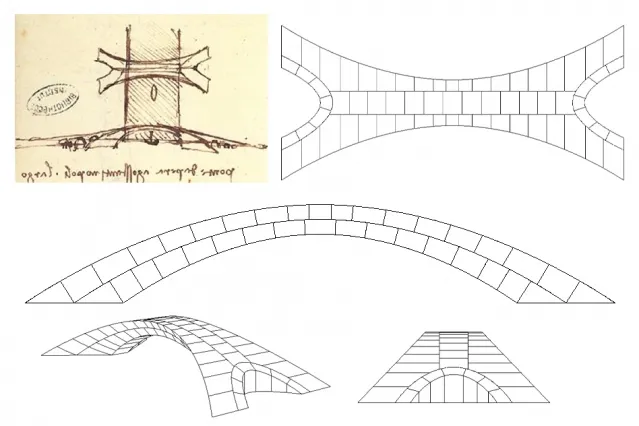Scientists Prove Leonardo da Vinci’s 500-Year-Old Bridge Design Actually Works
A model created at MIT shows the bridge, which would have been 10 times longer than typical ones, could have spanned the Golden Horn
/https://tf-cmsv2-smithsonianmag-media.s3.amazonaws.com/filer/e4/31/e431e216-9d24-4c82-bd1b-1b4ae57f6f00/leonardo_bridge.jpg)
Leonardo da Vinci wasn’t known for getting things done. He was often years or even decades late when delivering paintings, and many of the fantastical schemes he concocted (think giant horse statues and flying machines) barely progressed beyond the page.
Still, new research conducted by engineers at MIT suggests one of the Renaissance giant’s unbuilt designs—a bridge poised to be the world’s longest—would have worked if the artist had actually followed through on his plans.
Leonardo drafted his proposal in response to Sultan Bayezid II’s 1502 appeal for bridge designs. Bayezid, ruler of the Ottoman Empire, wanted to connect the cities of Constantinople and Galata, which were separated by a river estuary called the Golden Horn.
As Jennifer Ouellette reports for Ars Technica, the main obstacle raised by Leonardo’s design was the bridge’s proposed length: At 919 feet, it would have been around 10 times longer than most contemporary bridges. If workers tasked with bringing the artist’s vision to life used conventional building techniques, they would have needed at least ten piers to bolster the structure’s weight. These piers, in turn, would have prevented ships from passing underneath the bridge.
Leonardo’s pitch was radically different than any presented previously. According to a press release, he proposed building a single flattened arch tall enough to allow sailboats to pass below and stabilizing against lateral motion—an issue linked with the region’s many earthquakes—by adding splayed abutments, or load-carrying supports, to either side of the bridge.
Bayezid was unimpressed by Leonardo’s complicated blueprints, and the bridge the artist envisioned was never built—at least until MIT engineer John Ochsendorf stepped in to test the 500-year-old design’s feasibility.

Although Leonardo failed to specify the materials he intended to use for the bridge in either his sketches or correspondence, Ochsendorf and his colleagues analyzed materials available in 1502 and determined the Old Master would probably have used stone rather than wood or brick, neither of which could fully support such a heavy structure.
First, the team built a 1/500th model of the artist’s design. Measuring around 32 inches long, the prototype consisted of 126 3-D printed parts. Each piece took some six hours to print.
The researchers then put the blocks together, using scaffolding to support the bridge until the final keystone was inserted. This wedge-shaped stone locked the rest of the pieces in place through sheer force of compression.
“When we put [the keystone] in, we had to squeeze it,” engineering student Karly Bast, who worked on the project alongside undergraduate Michelle Xie, says. “That was the critical moment when we first put the bridge together. I had a lot of doubts.”
Bast adds, “When I put the keystone in, I thought, ‘This is going to work.’ And after that, we took the scaffolding out, and it stood up.”
To further test the model, the researchers placed the bridge on two movable platforms, creating horizontal motion representative of loose soil or an earthquake. The bridge managed stress relatively well, only deforming slightly before reaching the point of collapse.
Bast, Xie and Ochsendorf presented their project at the conference of the International Association for Shell and Spatial Structures earlier this month.
It’s unlikely anyone will ever create a full-scale masonry version of da Vinci’s design, as the introduction of stronger, lighter materials has made such a project impractical. Interestingly, Norway’s da Vinci Bridge—a pedestrian overpass opened in 2001—is loosely based on the 1502 sketch but uses steel and wood instead of masonry blocks.
Bast says Leonardo’s design offers insights despite the fact that it is ill-suited for the modern world. “What we can learn from Leonardo da Vinci’s design is that the form of a structure is very important for its stability,” she tells CNN’s Ashley Strickland. “Not only is Leonardo’s design structurally stable, but the structure is the architecture. It is important to understand this design because it is an example of how engineering and art are not independent from each other.”
Some questions regarding the design remain unanswered. According to Ouellette, Leonardo’s original sketch was lost for several centuries and only rediscovered in 1952. Researchers also don’t know how much time the artist dedicated to his proposal. He may have doodled it in just a few minutes or, alternatively, dedicated ample time to the project. Whatever the case, the design shows that the artist had a deep understanding of geometry and forces such as compression.
The first bridge to stretch across the Golden Horn wasn’t built until 1845. It lasted about 18 years and has since been replaced by newer iterations. Today, the Galata Bridge serves as a bustling vehicle and pedestrian thoroughfare; the bridge even boasts a drawbridge for passing ships.